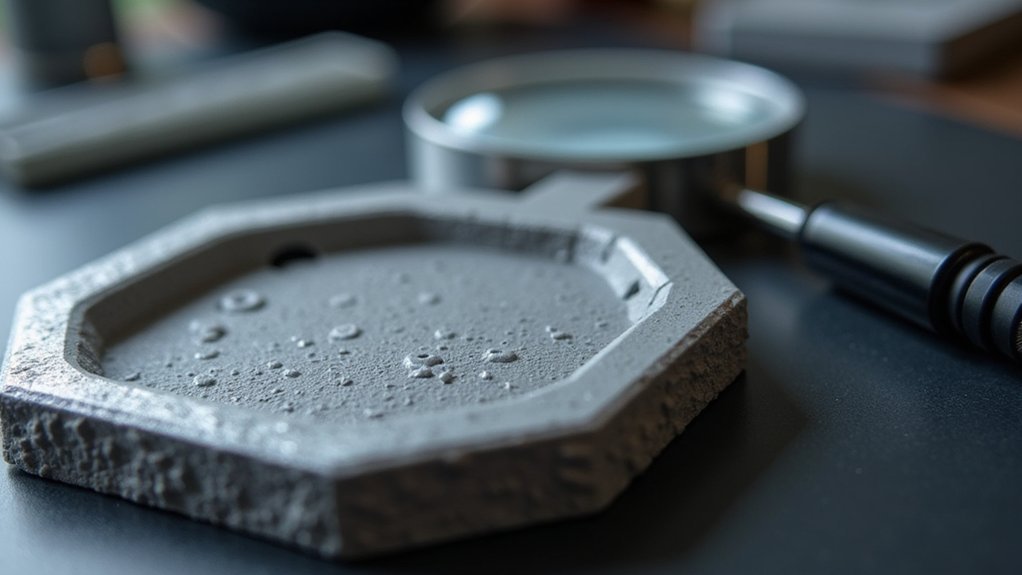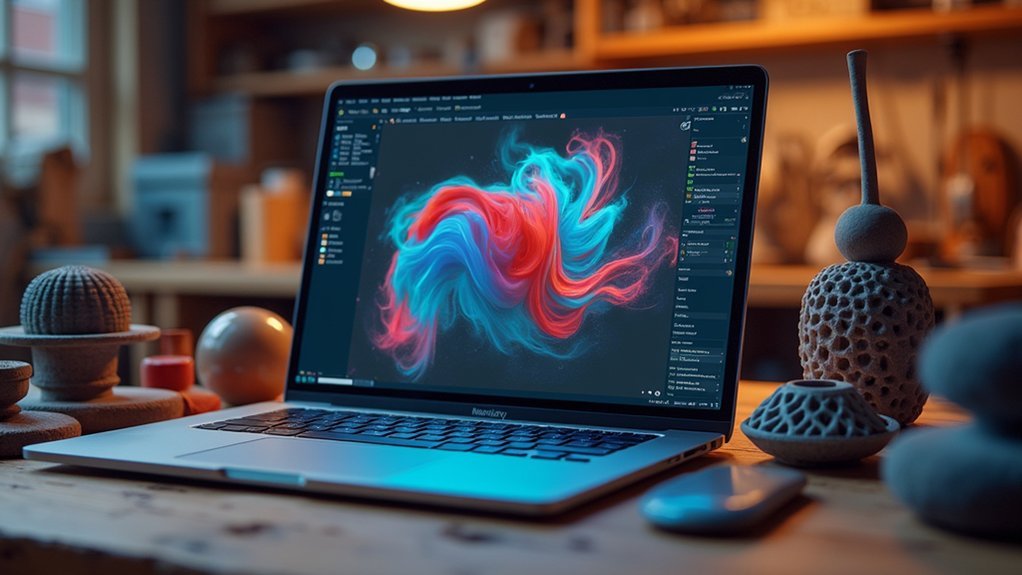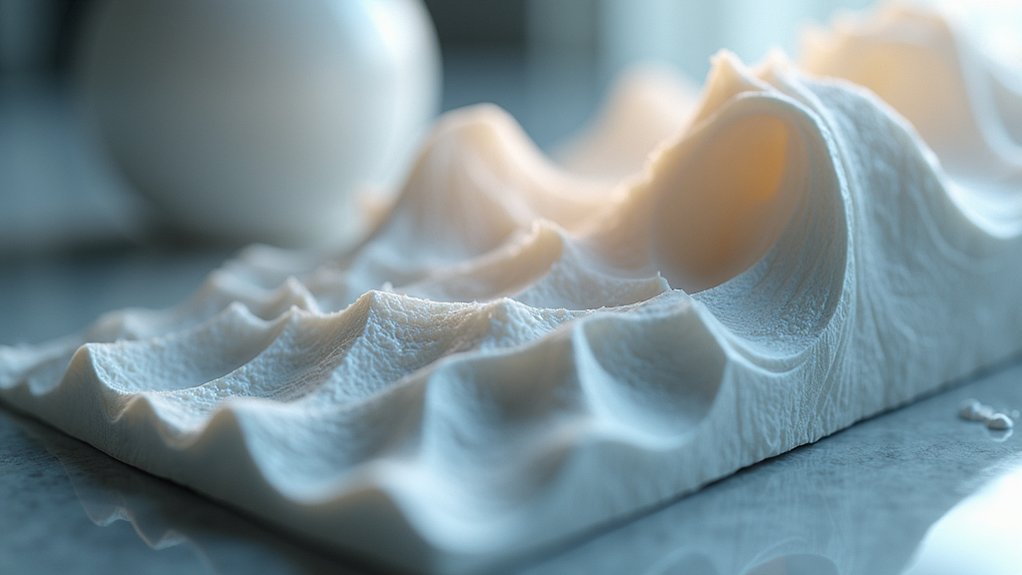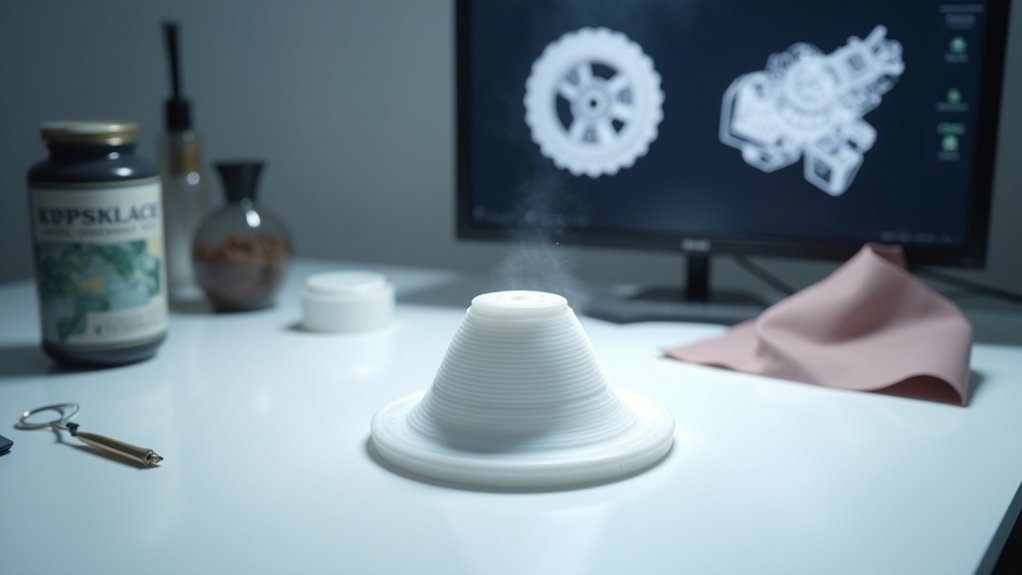You can achieve professional STL surface quality using three primary methods: automated smoothing in Meshmixer for efficient refinement, manual mesh editing in Blender for precise control over specific problem areas, and advanced remeshing algorithms like Laplacian smoothing that redistribute triangle geometry uniformly. Each technique offers different strengths—automated tools save time, manual editing provides targeted precision, and remeshing creates ideal triangle distribution for enhanced 3D printing results while managing file size considerations for reliable output.
Understanding STL File Surface Quality Issues

When you examine STL files closely, you’ll notice they often suffer from surface quality issues that stem from their fundamental mesh structure.
These files use larger, fewer triangles to create their mesh, resulting in a rough, faceted appearance that’s particularly noticeable in 3D printed objects. The coarse triangulation creates visible edges and angular surfaces where smooth curves should exist.
You can address these problems using various smoothing techniques, including applying a surface modifier that increases vertex and triangle counts.
However, poor mesh topology often complicates this process, making messy geometry difficult to smooth effectively. The underlying structure determines how well smoothing algorithms work, so understanding these limitations helps you choose appropriate methods for improving your STL file’s surface quality before printing.
Manual Mesh Editing Techniques in Blender
You can manually edit your STL mesh in Blender by selecting specific edges that need smoothing attention.
The Edge Selection method lets you target problem areas where jagged lines create unwanted surface irregularities.
Once you’ve identified these edges, you’ll apply the Subdivision Surface modifier to add geometry and create smoother changes.
Edge Selection Methods
Manual edge selection in Blender provides precise control over which areas of your STL mesh receive smoothing treatment.
You’ll access these edge selection methods by entering Edit Mode and activating the Edge Select tool to target specific mesh areas.
To enhance your smoothing results, use the “Edge Crease” feature to mark edges that should stay sharp while smoothing surrounding areas.
This preserves important details during the process.
After selecting your edges, apply the “Subdivide” function to increase vertex density, creating smoother surfaces through refined geometry.
You can also switch to Sculpt Mode and use the “Smooth” tool for manual adjustments with finer control.
Remember to toggle between Object Mode and Edit Mode frequently, allowing you to preview smoothing effects and maintain your model’s intended shape.
Subdivision Surface Modifier
Although edge selection gives you pinpoint control, Blender’s Subdivision Surface Modifier offers a more thorough approach to smoothing your entire STL mesh. You’ll find this tool increases polygon count through systematic subdivisions, creating refined surfaces across your model.
To implement the subdivision surface modifier, select your object and navigate to Modifier Properties. Add the modifier, then adjust View and Render levels until you achieve desired smoothness.
Clean topology is essential—messy geometry with non-manifold edges produces poor results.
For controlled sharpness in specific areas, add creases to edges before applying subdivision. This lets you maintain sharp details while smoothing other regions.
After applying the modifier, export as STL to preserve the new geometry, though expect increased file sizes.
Automated Smoothing With Meshmixer Tools

You’ll find Meshmixer’s automated smoothing tools offer a powerful alternative to manual mesh editing when you need efficient surface refinement.
The software’s Smooth tool and Sculpt mode brushes let you target specific areas with precision while maintaining control over the smoothing intensity.
However, you must consider how automated processing affects mesh density and detail preservation to achieve ideal output quality for your 3D printing needs.
Meshmixer Smooth Tool Features
When you’re looking to quickly enhance your STL files without diving into complex manual editing, Meshmixer’s Smooth Tool delivers automated smoothing that targets rough edges and surface imperfections with precision.
You can adjust the strength settings to control how much smoothing gets applied, giving you flexibility based on your model’s specific requirements.
The smooth tool lets you specify exactly which areas need attention, so you’ll preserve important geometry while enhancing surface quality where it matters most.
You can combine it with Sculpt Tool features to refine details while maintaining your model’s overall shape. This targeted approach means you won’t accidentally over-smooth critical features.
The automated capabilities dramatically reduce manual editing time, making it an efficient solution for preparing models for 3D printing.
Automated Selection and Processing
Meshmixer’s automated selection capabilities transform how you approach STL smoothing by intelligently identifying problem areas that need attention.
The software’s automated smoothing features streamline your workflow by processing selected regions with minimal manual intervention. You can configure automatic smoothing parameters through the Edit menu to control intensity and effect distribution across your chosen areas.
The triangle selection system guarantees you’re targeting specific problem zones while preserving critical model details.
Key automated smoothing benefits include:
- Intelligent area detection – Automatically identifies rough surfaces requiring attention
- Parameter-driven processing – Set intensity levels for consistent smoothing results
- Selective application – Target specific regions without affecting the entire model
- Error prevention – Inspector tool integration catches mesh issues before processing
This automated approach saves time while maintaining precision control over your STL modifications.
Output Quality Considerations
Although automated smoothing delivers impressive results, understanding the quality trade-offs guarantees you make informed decisions about your STL processing workflow.
Meshmixer’s adjustable smoothing strength lets you balance surface refinement with detail preservation. You’ll find that selective application maintains critical features while improving rough areas.
Before applying smoothing, run Meshmixer’s Inspector tool to identify mesh issues that could compromise results. Clean meshes respond better to smoothing operations and produce superior surface quality.
Consider the file size implications when smoothing extensively. The process adds vertices and triangles, increasing your STL’s memory footprint.
However, this trade-off often proves worthwhile when you need professional-quality surfaces. The time savings compared to manual edge cleanup makes automated smoothing particularly valuable for complex models requiring consistent surface finish.
Subdivision Surface Modifiers for Enhanced Detail

While basic smoothing algorithms can improve surface quality, subdivision surface modifiers take STL enhancement to the next level by intelligently adding geometry where it’s needed most.
Software like Blender offers these powerful tools that balance smoothness with polygon count control, letting you maintain manageable file sizes while achieving professional results.
You’ll need well-structured mesh topology before applying subdivision surface modifiers, as messy triangular geometry can hinder effective smoothing.
Adding creases to edges beforehand helps preserve sharp features while maintaining overall surface smoothness.
Key benefits of subdivision surface modifiers include:
- Adjustable subdivision levels for ideal smoothness-to-file-size ratios
- Enhanced surface quality perfect for 3D printing applications
- Intelligent geometry addition that focuses detail where needed
- Professional-grade results with proper mesh preparation
Laplacian and Taubin Smoothing Algorithms
When precision matters more than speed, Laplacian and Taubin smoothing algorithms deliver mathematical elegance that transforms rough STL surfaces into refined geometry. Both algorithms work by repositioning vertices based on neighboring vertex positions, but they differ in execution and results.
Laplacian smoothing averages each vertex position with its neighbors, reducing noise while maintaining overall mesh shape. It’s computationally efficient for real-time applications, making it perfect when you need quick results.
However, Taubin smoothing introduces weighting factors that prevent volume shrinkage, preserving geometric fidelity better than basic Laplacian methods.
You’ll find both algorithms in most 3D modeling software, where you can apply them iteratively until achieving desired smoothness. They’re particularly valuable for 3D printing preparation, eliminating sharp edges and irregularities that compromise print quality.
Remeshing Strategies for Uniform Triangle Distribution
Since irregular triangle distributions create surface artifacts that compromise print quality, remeshing strategies focus on redistributing mesh geometry into uniform patterns that enhance both visual appearance and structural integrity.
You’ll find that effective remeshing converts your existing mesh topology into cleaner, more consistent triangle arrangements that eliminate printing defects.
When implementing remeshing strategies, you should consider:
- Triangle density adjustment – Control mesh resolution to match your printer’s capabilities while preserving essential details
- Surface detail preservation – Use algorithms that maintain important features during the redistribution process
- File enhancement – Reduce complexity and size for improved slicing performance
- Consistent sizing – Maintain uniform triangle dimensions across the entire model surface
Tools like Blender and Meshmixer provide sophisticated remeshing capabilities that’ll help you achieve superior results for 3D printing applications.
Software Comparison for STL Smoothing Workflows
Although each software solution offers distinct advantages for STL smoothing, choosing the right tool depends on your specific workflow requirements and technical expertise. When you need to edit STL files, Blender provides powerful subdivision surfaces but demands significant learning investment. Meshmixer excels with targeted smoothing tools and intuitive interfaces, though stability concerns affect larger projects. MeshLab delivers advanced remeshing capabilities but overwhelms users with complex filters and no undo functionality.
| Software | Best For |
|---|---|
| Blender | Complex smoothing with manual control |
| Meshmixer | User-friendly targeted refinements |
| MeshLab | Advanced remeshing operations |
| Netfabb | Basic repair and mesh integrity |
Netfabb suits engineers requiring mesh repair but lacks extensive smoothing features. FreeCAD imports STL files but produces poor export quality, necessitating additional cleanup workflows.
Balancing File Size and Surface Quality for 3D Printing
Finding the sweet spot between surface quality and file size determines your 3D printing success more than any other factor in STL smoothing workflows.
Mastering the balance between STL surface quality and file size is the cornerstone of successful 3D printing workflows.
You’ll need to carefully adjust export resolution settings, as higher resolution improves surface quality but creates larger files that complicate printing processes.
Consider these key strategies for ideal balance:
- Use Blender’s Subdivision Surface modifier sparingly to avoid exponential triangle count increases.
- Apply Autodesk Meshmixer’s selective smoothing to preserve detail in critical areas while managing overall file size.
- Recreate complex models in CAD software for better polygon density control.
- Test multiple resolution settings to find the minimum detail level that maintains print quality.
Remember that overly detailed meshes introduce printing errors, while low-resolution exports compromise aesthetic quality.
Strategic file size management guarantees reliable printing without sacrificing visual appeal.
Frequently Asked Questions
How to Make STL Files Smoother?
You can smooth STL files using Blender’s Subdivision Surface modifier, Autodesk Meshmixer’s smoothing tool, or recreating models in CAD software like Fusion 360 for higher resolution exports and better surface quality.
What Is the Smoothest 3D Printing Method?
You’ll achieve the smoothest 3D printing results using resin-based SLA or DLP printers with fine layer heights, followed by post-processing techniques like sanding, polishing, and chemical smoothing treatments.
How to Make a 3D Model Smoother?
You can smooth your 3D model by using Blender’s Subdivision Surface modifier, Autodesk Meshmixer’s smooth tool, recreating it in Fusion 360, or manually refining surfaces in Blender’s sculpt mode.
Why Is My STL File Not Smooth?
Your STL file isn’t smooth because it’s made of larger triangles that create a rough mesh surface. Poor export settings, geometry issues, or disconnected vertices also contribute to the jagged appearance.





Leave a Reply